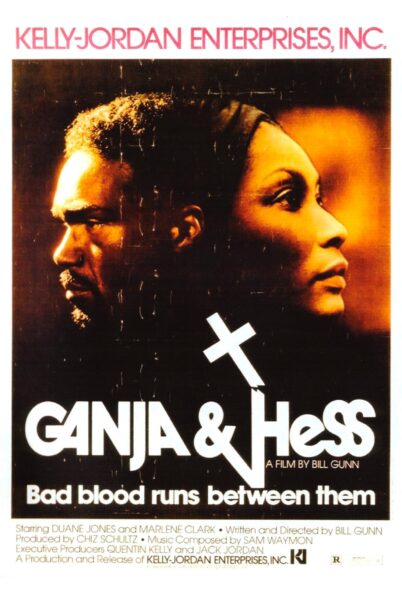 “The last thing Bill Gunn wanted to make was a black vampire film.” So claims producer Chiz Schultz about this black vampire film from writer-director Bill Gunn. GANJA & HESS (1973), starring NIGHT OF THE LIVING DEAD’S late Duane Jones (1937-1988) and Marlene Clark (a returnee from Gunn’s previous feature STOP!), came about due to the success of the blaxploitation horror classic BLACULA (1972), but Gunn had zero interest in horror or exploitation. What he delivered is very much an art film with very little in the way of traditional genre movie trappings (the word “vampire” is never uttered).
“The last thing Bill Gunn wanted to make was a black vampire film.” So claims producer Chiz Schultz about this black vampire film from writer-director Bill Gunn. GANJA & HESS (1973), starring NIGHT OF THE LIVING DEAD’S late Duane Jones (1937-1988) and Marlene Clark (a returnee from Gunn’s previous feature STOP!), came about due to the success of the blaxploitation horror classic BLACULA (1972), but Gunn had zero interest in horror or exploitation. What he delivered is very much an art film with very little in the way of traditional genre movie trappings (the word “vampire” is never uttered).
Kelly-Jordan Enterprises, a short lived production outfit dedicated to black cinema, was the instigator and distributor of GANJA & HESS. The film was, unsurprisingly, an abject flop, and one of the major catalysts in Kelly-Jordan’s downfall. Yet GANJA & HESS quickly amassed a cult following (something Kelly-Jordan’s other releases CLAUDINE and HONEYBABY, HONEYBABY failed to achieve), and is iconic enough that Spike Lee was moved to remake it in the form of DA SWEET BLOOD OF JESUS (2014). Gunn, however, never directed another feature (for the record, he was fired from the Muhammed Ali biopic THE GREATEST and had a proposed late 1980s feature called THE TERRITORY collapse after its main actor died).
According to one Gunn confidante, GANJA & HESS was made in three parts, “the one (Bill Gunn) wrote, the one he made and the one that was released.” Entitled BLOOD COUPLE, DOUBLE POSSESSION and BLACK VAMPIRE, that release version was pared down to 83 minutes (30 minutes shy of the initial run time), although it nonetheless contained scenes that don’t appear in any other cut, including the “Complete Editions” released on DVD and Blu-ray—which are, in any event, now the most widely available versions of GANJA & HESS.
Hess Green (Jones) is (like Gunn) an aristocratic black man. He resides in a decaying mansion in the upscale Westchester County, NY, where he’s apparently “the only colored on the block.” As a succession of textual intertitles inform us, Hess was killed while studying the “ancient black civilization of Myrthia,” but resurrected with a ravenous addiction to blood. Those past tense intertitles suggest that Hess’ conversion happened before the film starts, but what they describe actually occurs twenty minutes in, with Hess’ disturbed pal Meda (Gunn) using a ceremonial Myrthian dagger to stab him to death. Meda then writes a poem addressed to “the Black Male Children,” in which he posits that “You are the despised of the Earth,” and shoots himself in Hess’s bathroom. Hess, awakening from his (un)death, hears the gunshot and finds Meda’s corpse, from which Hess ravenously drinks the expiring blood.
Hess takes to stealing blood plasma from a blood bank, and offs a hoe (Candece Tarpley) and her pimp (Tommy Lane), whose life essence provides Hess with more of the desired sustenance. Then he meets Meda’s wife Ganja (Clark) and things change. She’s an elegant aesthete with a snooty air that compliments Hess’ aristocratic bearing; the two quickly become lovers, and Ganja moves into the mansion. Inevitably she discovers her husband’s cadaver stashed in the wine cellar, which changes the dynamic between her and Hess (“How come every rich man I meet is so fucked up?” she ponders).
He vampirizes her, and this “blood couple” christen their new existence by seducing and killing a young man. But Hess finds himself drawn to a church run be his devout chauffeur (Sam Waymon) and undergoes a spiritual transformation, just as Ganja increasingly embraces the vampire lifestyle.
Gunn’s artistic orientation ensures that the proceedings are never much fun, being reserved and humorless. The film is also virtually plotless, with a (deliberately) meandering and enigmatic narrative that the viewer is tasked with figuring out for him/herself (with a lengthy textual preamble and expository narration utilized for narrative clarity). The editing by Victor Kanefsky adheres to the subliminal and poetic, eschewing linear storytelling and even the details of Gunn’s own script—a tendency furthered by the contributions of first time film composer Sam Waymon, whose score encompasses Jewish bells, African chants, electric harps and various sounds made from silverware.
What results is a film with a style and atmosphere unique to itself. The hallucinatory air that infused Gunn’s previous feature STOP! is enhanced in GANJA AND HESS, which has a downright Lovecraftian sense of centuries-old African mysticism overtaking the American bred protagonist’s reality (look for Mabel King, of WHAT’s HAPPENING!!! and THE JERK, as an African queen). It’s all undeniably compelling—demanding, yes, but compelling.
Vital Statistics
GANJA AND HESS
Kelly-Jordan Enterprises
Director: Bill Gunn
Producer: Chiz Schultz
Screenplay: Bill Gunn
Cinematography: Jim Hinton
Editing: Victor Kanefsky
Cast: Duane Jones, Marlene Clark, Bill Gunn, Sam Waymon, Leonard Jackson, Candece Tarpley, Richard Harrow, John Hoffmeister, Betty Barney, Mabel King, Betsy Thurman, Enrico Fales, Tommy Lane, Tara Fields
